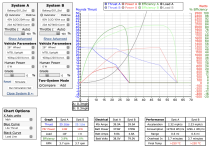drutledge
10 W
I bought two super cheap Bafang G320.250 off of ebay to convert bikes for guests who want to tag along on e-bike rides. These are rated at 250W so they are not much. I have identical old (been in a box for at least 7 years?) Grin 20Amp controllers in each setup. One bike I gave a 42V 20Ah battery, the other got an 84V 10Ah one I had around. The 42V one is anemic (15mph top speed and slow off the line) but does fine. The 84V one shedded it's gears on the first big hill I came to; oops. I've ordered new gears but I obviously don't want this to happen again. I want the extra speed that the higher voltages will give me but need to not shred gears. I have an old programmable Grin Phaserunner around and was going to use that to limit the phase amps going into the motor. Any ideas on what these motors can handle safely? Anyone know what the old 20A Grin controllers put out?
Also as a side-note, I ran the numbers on Grin's motor simulator, using the smallest Bafang they have in the list. It shows that the motor amps (Phase amps?) are the same from a standing start (0 mph, full throttle) for either voltage. Is this correct? If phase amps are the same for different voltages, what should I be limiting on the Phaserunner controller to prevent shredded gears.

Also as a side-note, I ran the numbers on Grin's motor simulator, using the smallest Bafang they have in the list. It shows that the motor amps (Phase amps?) are the same from a standing start (0 mph, full throttle) for either voltage. Is this correct? If phase amps are the same for different voltages, what should I be limiting on the Phaserunner controller to prevent shredded gears.


